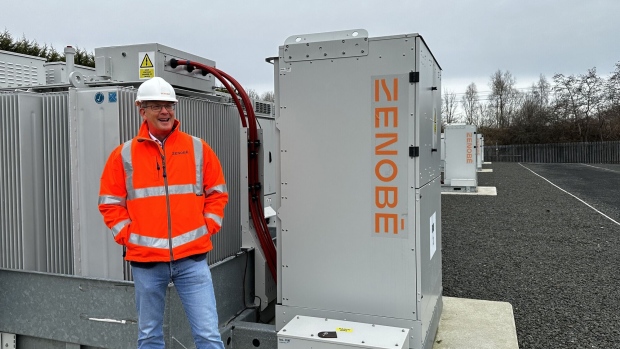Feb 15, 2024
Batteries for Europe’s Grids May Finally Be Ready to Take Off
, Bloomberg News

(Bloomberg) -- Europe is on the brink of an enormous surge in battery projects for the grid after a half-decade of stumbling without a clear strategy.
There could be a sevenfold increase to more than 50 gigawatts in capacity connected to transmission networks by 2030, according to Aurora Energy Research Ltd. The UK, Italy and Ireland are the top three markets for storage investment within the region, with Spain and Greece emerging.
“Grid-scale battery building was already picking up in 2023 and is now increasing its speed,” said Ryan Alexander, lead researcher for European power markets at Aurora, which released its report Tuesday.
As Europe rapidly expands its use of renewable energy to meet climate goals, batteries play a crucial role in the power market because they can store electricity when it’s plentiful and discharge when it’s scarce. Progress has been slow because many network operators don’t procure services batteries can provide, such as firing up rapidly when the wind drops, and there are long waits for grid connections.
Batteries don’t operate all the time like a conventional power station, so operators need contracts with the grid to provide services like balancing for frequency and voltage. An ancillary services market, where batteries can find multiple revenue streams, is crucial for investment and development.
“There isn’t an alternative technology that can respond as quickly as batteries,” said James Basden, co-founder of maker Zenobe Energy Ltd. “Net zero doesn’t happen without batteries.”
Some nations are backing them in a big way short-term. The UK is forecast to quintuple energy storage capacity by 2030 through auctions and accelerated battery connections to the network.
Australia’s utility-scale installations will more than double this year, and the US Inflation Reduction Act is juicing investment tax credits in America.
Britain has been a front-runner on the continent, adding more large-scale capacity in 2022 than any other nation, according to the European Association for Storage of Energy industry group.
The country’s grid offers contracts to solve issues concerning voltage, inertia and short circuits.
“The UK put an onus on battery storage before anyone else did,” said Michael Longson, a commercial associate at London private equity firm Gore Street Capital, which focuses on energy storage. “We have our own services that only batteries can deliver.”
The UK’s advanced planning paid off in December when a cable connecting the power grid to France suffered a brief outage, causing a precipitous drop in frequency. The fall exceeded permitted limits in seconds and almost triggered a blackout, but batteries stepped in to make up about 40% of the shortfall.
So what’s taking the rest of Europe so long?
It’s not a case of penny-pinching: the EU spent $341 billion last year on deploying clean technologies — a 35% increase from the year before, according to BloombergNEF.
Energy storage, for utilities and individual users, accounted for $8.4 billion of that -– a 64% increase in the same period.
“You will see exponential growth in batteries across the globe, and the primary driver of that is how cheap renewable energy has become,” said Peter Kavanagh, chief executive officer of Harmony Energy Storage Ltd. “You can only build out a certain amount of renewables without storage.”
Even so, energy storage isn’t clearly defined in the bloc’s legislation, leading to unnecessary costs, excessive red tape and an uncertain investment environment, according to the EU Agency for the Cooperation of Energy Regulators, or ACER.
For example, Germany considers batteries to be both producers and consumers of energy, meaning companies deploying them must pay twice for a grid connection. Streamlining legislation was introduced in July.
The EU also requires development plans to be approved by individual states, which have differing requirements and definitions. That means companies can’t cut-and-paste business models across borders.
“France, Germany, Poland are seeing what’s happening in the UK and saying, ‘Great, batteries work,’” said Kavanagh, whose company operates utility-scale installations across the UK. “Let’s embrace and change policy to enable them.”
Some progress is being made. In December, the EU approved Italy’s plan to allocate €17.7 billion ($19 billion) for building more than 9 gigawatts of storage.
German power giant RWE AG is constructing a utility-scale project in the Netherlands to help integrate its OranjeWind offshore farm into the grid. At home, the company commissioned a megabattery in Lingen and Werne, and is building a similar-sized system at two locations in North Rhine-Westphalia.
Households in Germany and the Netherlands have been installing home-scale batteries at a rapid pace, partly supported by public funding. Residential batteries are now the largest source of storage demand in the region and will remain so until 2025, when grid scale ramps up in a big way, BNEF said.
The recent announcement by Germany, the region’s largest economy, to design and implement elements of a capacity market by 2028 is likely to create even stronger incentives for developers and investors to build out additional grid-scale battery capacity.
“Grid operators will want to rely on stationary batteries to help when the system needs it, and not cross their fingers that you have your EV plugged in at home to help,” Alexander said.
--With assistance from Petra Sorge, William Mathis and Nelson Nsitem.
©2024 Bloomberg L.P.






